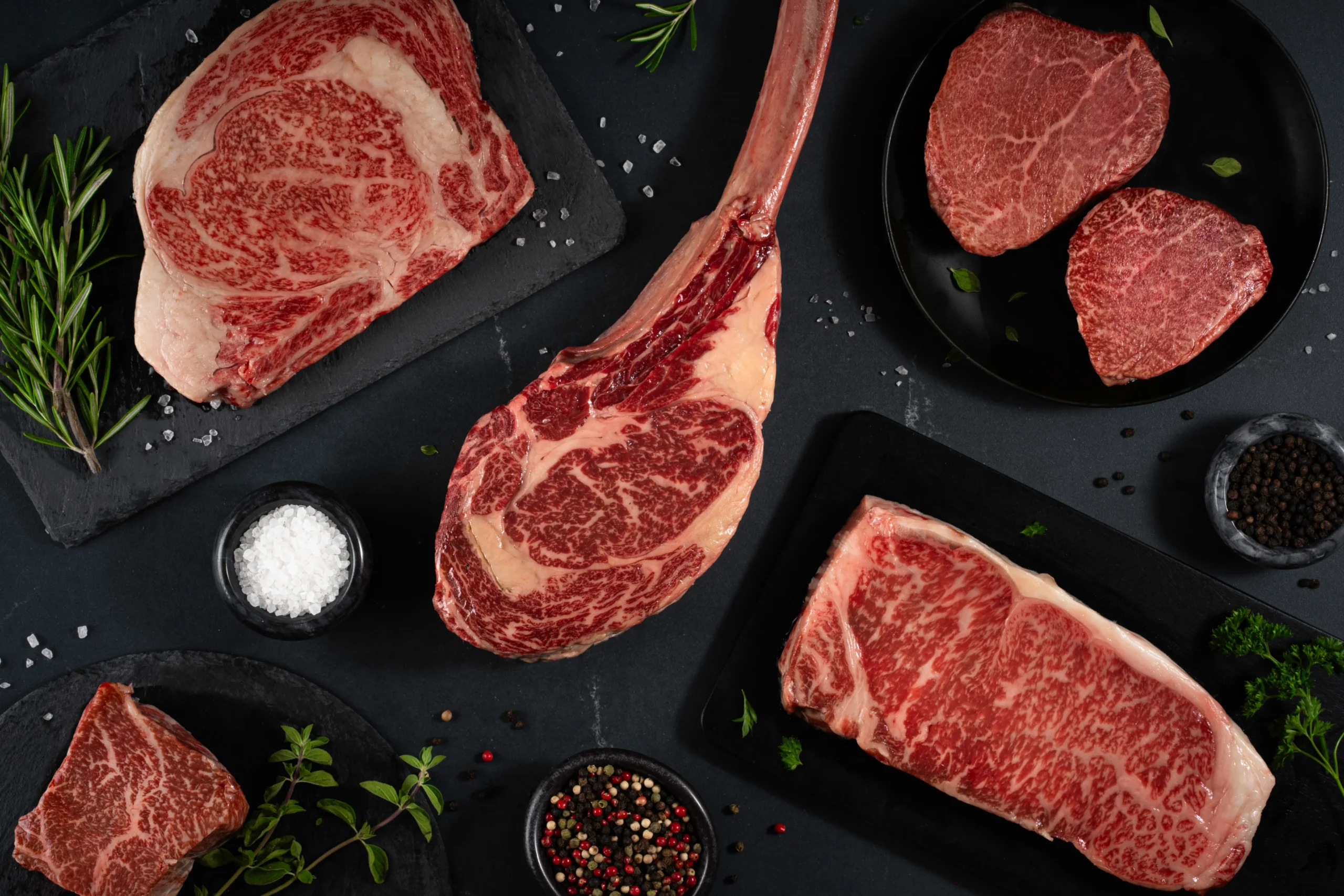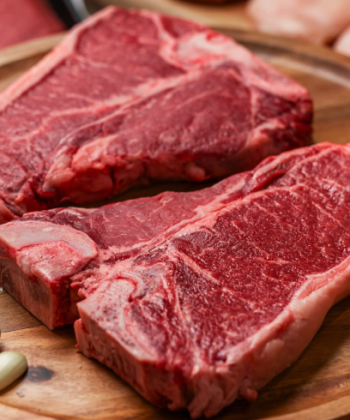
Japanese Wagyu is not just a type of beef; it is a centuries-old tradition that embodies meticulous craftsmanship and reverence for quality. The roots of Wagyu trace back to Japan’s ancient agricultural practices, where cattle were primarily used for farming. Over time, selective breeding transformed these animals into a source of unparalleled culinary excellence. The reverence for Wagyu in Japan is intertwined with cultural values such as patience, precision, and respect for nature.
The term “Wagyu” itself translates to “Japanese cow,” but its meaning extends far beyond mere nomenclature. The cattle breeds—Kuroge (Black), Akage (Red), Mukaku (Polled), and Nihon Tankaku (Shorthorn)—are carefully managed to maintain the integrity of their lineage. The process of raising Wagyu cattle, which involves attention to their diet, stress levels, and even individual care, reflects Japan’s devotion to excellence. Each cut of meat carries the legacy of farmers who have perfected their craft over generations.
This historical significance is not just about culinary appreciation; it is about preserving a cultural identity. As Wagyu gains popularity worldwide, Japan has taken great care to protect its authenticity through regulations and certifications. Such measures ensure that when you experience authentic Japanese Wagyu, you are tasting history, not just beef.
What Sets Wagyu Apart: The Science of Marbling
One of the defining features of Japanese Wagyu is its extraordinary marbling, scientifically known as intramuscular fat. Unlike other beef, where fat often forms as an unappetizing gristle, Wagyu’s marbling is fine, consistent, and melts at a low temperature, creating its signature buttery texture. The delicate balance between fat and meat results in a flavor profile that is rich yet never overwhelming.
The unique marbling is no accident; it is a direct result of meticulous breeding and care. Japanese farmers employ precise techniques, such as controlling feed ratios and using stress-reducing methods, to ensure the cattle’s well-being. These measures lead to the development of high-quality fat that integrates seamlessly into the muscle. The result is beef that not only tastes exquisite but is also healthier than one might assume, as its monounsaturated fat content is higher than in other types of red meat.
This unparalleled quality makes Japanese Wagyu a standout in the global beef market. Premium retailers like Destination Wagyu, who specialize in offering authentic cuts, are integral to preserving the essence of this luxurious delicacy. By sourcing from reputable farms in Japan, they ensure that what reaches consumers is not only genuine but also of the highest standard.
Regional Varieties: Exploring the Diversity of Wagyu
Japan is home to several regions, each with its distinct Wagyu variety, showcasing local nuances in flavor and texture. Kobe beef, perhaps the most internationally recognized, originates from the Hyogo Prefecture and exemplifies intense marbling and a delicate sweetness. Matsusaka beef, from Mie Prefecture, is revered for its melt-in-your-mouth quality, achieved through stringent feeding protocols.
Another notable variety is Omi beef from Shiga Prefecture, one of the oldest and most prestigious types of Wagyu. With a history spanning over 400 years, Omi beef is known for its robust umami flavor. Similarly, Hida beef from Gifu Prefecture distinguishes itself with a fine grain texture and unparalleled tenderness, reflecting the region’s pristine environment and careful farming practices.
These regional differences highlight the artistry and diversity within Wagyu production. Just as French wines are celebrated for their terroir, Japanese Wagyu embodies the characteristics of its birthplace. This intricate connection between geography and gastronomy adds depth to the experience of savoring Wagyu.
The Ritual of Raising Wagyu: A Farmer’s Devotion
The process of raising Wagyu cattle is a labor-intensive endeavor that prioritizes the animal’s welfare above all else. Farmers treat their cattle almost as family, ensuring they lead stress-free lives. This involves providing them with a carefully curated diet, often comprising rice straw, corn, and barley, and even playing classical music to create a calming environment.
The attention to detail extends to monitoring the cattle’s health and weight at every stage of their life. Regular check-ups and tailored feeding schedules ensure that each animal achieves the ideal fat-to-muscle ratio. Unlike factory farming methods, which prioritize efficiency, Wagyu farming focuses on quality, often requiring years to produce a single premium cut of beef.
This dedication is not just about producing high-grade meat; it reflects a broader cultural ethos of respecting nature and taking pride in one’s work. For Japanese Wagyu farmers, their craft is a lifelong commitment, passed down through generations, ensuring that tradition remains intact.
The Culinary Experience: Why Wagyu Transcends Taste
Eating Wagyu is more than a meal—it is an experience that engages all the senses. The first bite introduces you to a complex interplay of textures and flavors. The fat’s low melting point allows it to dissolve on the palate, releasing a rich umami flavor that lingers. This sensory indulgence is often enhanced by traditional Japanese preparation methods, such as sukiyaki and shabu-shabu, which highlight the beef’s natural flavors.
The versatility of Wagyu extends to Western cuisines as well. From Wagyu steaks to gourmet burgers, chefs worldwide incorporate this premium beef into their creations. However, regardless of the preparation method, the essence of Wagyu lies in its simplicity. The meat’s intrinsic quality requires minimal seasoning, allowing its natural flavors to shine.
Beyond its taste, the presentation of Wagyu is an art in itself. From its intricate marbling to the precision in slicing, every detail reflects the pride and tradition behind its production. For diners, it is not just a dish but a story of heritage and artistry.
The Global Appeal of Wagyu: A Growing Phenomenon
While Wagyu remains a deeply rooted Japanese tradition, its global popularity continues to rise. International chefs and food connoisseurs are captivated by its unparalleled quality, making it a centerpiece in fine dining establishments worldwide. This demand has also led to the development of Wagyu hybrids in countries like the United States and Australia.
However, authentic Japanese Wagyu retains a unique appeal due to its stringent certification standards. The Japanese government issues a seal of authenticity for Wagyu exported from its shores, ensuring that only the finest products reach global markets. This commitment to quality has solidified Japan’s position as the ultimate authority on Wagyu.
As more consumers seek out Wagyu, it has become a symbol of luxury and excellence. Yet, its roots remain deeply tied to the traditions and craftsmanship that define Japanese culture. This balance between global appeal and cultural preservation ensures Wagyu’s enduring legacy.
The Future of Wagyu: Balancing Tradition and Innovation
The future of Wagyu lies in the delicate balance between maintaining tradition and embracing innovation. While Japanese farmers continue to uphold centuries-old practices, advancements in technology, such as genetic tracking and sustainable farming methods, are beginning to play a role in Wagyu production.
Sustainability is an emerging focus, as the global demand for Wagyu necessitates eco-friendly practices. Farmers are exploring ways to reduce the environmental impact of cattle raising, such as optimizing feed efficiency and utilizing renewable energy sources on farms. These efforts ensure that Wagyu production can thrive without compromising the planet’s health.
At its core, Wagyu remains a testament to Japan’s dedication to perfection. As the world embraces this extraordinary beef, the challenge will be to preserve its authenticity while adapting to modern demands. In doing so, Wagyu will continue to be more than just beef—it will remain a living tradition.


